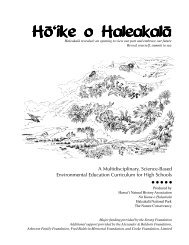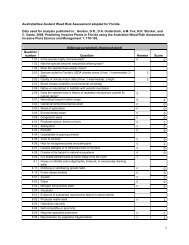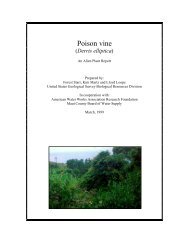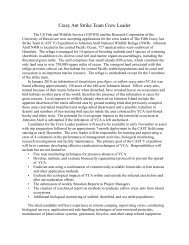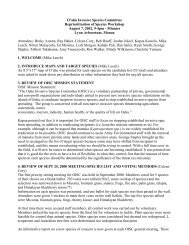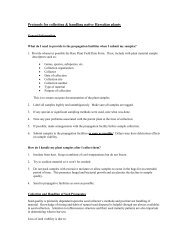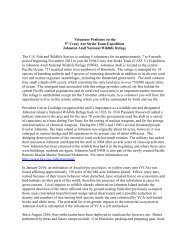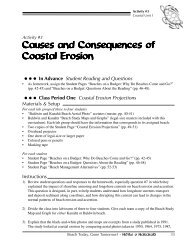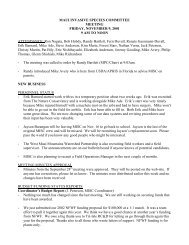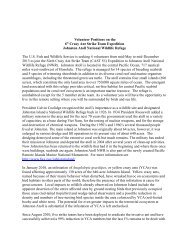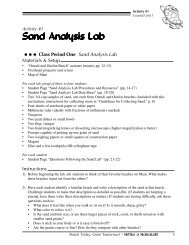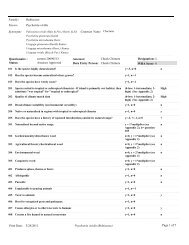Report to the Republic of Palau: 2008 update on Invasive Plant ...
Report to the Republic of Palau: 2008 update on Invasive Plant ...
Report to the Republic of Palau: 2008 update on Invasive Plant ...
Create successful ePaper yourself
Turn your PDF publications into a flip-book with our unique Google optimized e-Paper software.
introduced <str<strong>on</strong>g>to</str<strong>on</strong>g> Penrhyn Island (Cook Islands) when an airfield was built <str<strong>on</strong>g>the</str<strong>on</strong>g>re during <str<strong>on</strong>g>the</str<strong>on</strong>g> Sec<strong>on</strong>d<br />
World War (Bill Sykes, pers. com.) and are present elsewhere in <str<strong>on</strong>g>the</str<strong>on</strong>g> Pacific where military<br />
airfields were c<strong>on</strong>structed. Pluchea indica is found al<strong>on</strong>g <str<strong>on</strong>g>the</str<strong>on</strong>g> seashore and inland <strong>on</strong> poorer sites<br />
<strong>on</strong> both Peleliu and Angaur while P. carolinensis is located al<strong>on</strong>g <str<strong>on</strong>g>the</str<strong>on</strong>g> airstrip <strong>on</strong> Peleliu.<br />
Pi<str<strong>on</strong>g>the</str<strong>on</strong>g>cellobium dulce (kamatsíri, opiuma, Madras thorn) is a thorny tree that is a problem species<br />
in Hawai‘i. It is present <strong>on</strong> many <str<strong>on</strong>g>of</str<strong>on</strong>g> <str<strong>on</strong>g>the</str<strong>on</strong>g> major islands <str<strong>on</strong>g>of</str<strong>on</strong>g> Micr<strong>on</strong>esia, but doesn’t seem <str<strong>on</strong>g>to</str<strong>on</strong>g> be a<br />
serious problem. The seeds are bird-dispersed and its sap can cause eye irritati<strong>on</strong> and skin welts.<br />
It is relatively resistant <str<strong>on</strong>g>to</str<strong>on</strong>g> fire and resprouts rapidly by basal or aerial shoots. It was reported<br />
cultivated <strong>on</strong> Koror by Fosberg et al. (1979) but that tree has not been seen in recent surveys. A<br />
planted tree was seen in Airai during this survey. Its weed risk assessment gives it a score <str<strong>on</strong>g>of</str<strong>on</strong>g> 14<br />
and rates it “high risk”.<br />
Psidium cattleianum (strawberry guava), a small tree that forms dense thickets, was previously<br />
reported <str<strong>on</strong>g>to</str<strong>on</strong>g> be present <strong>on</strong> Koror (Fosberg et al., 1979), perhaps in cultivati<strong>on</strong>, but was not found<br />
during this or <str<strong>on</strong>g>the</str<strong>on</strong>g> previous survey. It is a major problem species in a number <str<strong>on</strong>g>of</str<strong>on</strong>g> island<br />
ecosystems including Hawai‘i and Tahiti in <str<strong>on</strong>g>the</str<strong>on</strong>g> Pacific and La Réuni<strong>on</strong> and Mauritius in <str<strong>on</strong>g>the</str<strong>on</strong>g><br />
Indian Ocean. Varieties with red and yellow fruits are known. Birds and pigs (and possibly fruit<br />
bats as well) disperse <str<strong>on</strong>g>the</str<strong>on</strong>g> seeds. This is an extremely dangerous species with a weed risk<br />
assessment score <str<strong>on</strong>g>of</str<strong>on</strong>g> 18.<br />
Solanum <str<strong>on</strong>g>to</str<strong>on</strong>g>rvum (prickly solanum, devil’s fig) is a large spiny shrub <str<strong>on</strong>g>of</str<strong>on</strong>g> disturbed areas and fields<br />
that can form dense, impenetrable thickets. Its seeds are bird-spread. The principal infestati<strong>on</strong><br />
(apparently a number <str<strong>on</strong>g>of</str<strong>on</strong>g> individual plants) is in and around Nekken in Ngatpang and Aimeliik<br />
States, Babeldaob. A leaf-eating chrysomelid beetle, Leptinotarsa undecimlineata, is reported <str<strong>on</strong>g>to</str<strong>on</strong>g><br />
be host-specific (Waterhouse and Norris, 1987) but would probably not be effective <strong>on</strong> <str<strong>on</strong>g>the</str<strong>on</strong>g><br />
scattered plants found <strong>on</strong> Babeldaob.<br />
Syng<strong>on</strong>ium angustatum (arrowhead plant, goosefoot plant), a climbing aroid, is widely cultivated<br />
in <str<strong>on</strong>g>Palau</str<strong>on</strong>g>, particularly in Koror and Airai States, and a number <str<strong>on</strong>g>of</str<strong>on</strong>g> escapes were noted both in this<br />
and <str<strong>on</strong>g>the</str<strong>on</strong>g> previous survey. This species has <str<strong>on</strong>g>the</str<strong>on</strong>g> ability <str<strong>on</strong>g>to</str<strong>on</strong>g> spread in <str<strong>on</strong>g>the</str<strong>on</strong>g> deep shade <str<strong>on</strong>g>of</str<strong>on</strong>g> intact forests,<br />
forming a dense mat <strong>on</strong> <str<strong>on</strong>g>the</str<strong>on</strong>g> forest floor as well as climbing trees. It is difficult <str<strong>on</strong>g>to</str<strong>on</strong>g> eradicate as it<br />
is able <str<strong>on</strong>g>to</str<strong>on</strong>g> reproduce from a single node and stem and root fragments are easily overlooked. It<br />
spreads vegetatively from dumped cuttings. It is a problem species in American Samoa, is<br />
widespread in Hawai‘i and is quite invasive in Niue. An almost identical species, Syng<strong>on</strong>ium<br />
podophyllum, has a weed risk assessment score <str<strong>on</strong>g>of</str<strong>on</strong>g> 15, “high risk”, that can also be applied <str<strong>on</strong>g>to</str<strong>on</strong>g> this<br />
species.<br />
Syzygium cumini (mesekerrák, Java plum) is reported <str<strong>on</strong>g>to</str<strong>on</strong>g> be present, perhaps in cultivati<strong>on</strong>, <strong>on</strong><br />
Koror, Babeldaob and Aulupse‘el (Rock Islands) (Fosberg et al., 1979; Raulers<strong>on</strong> et al., 1996)<br />
but was not seen in ei<str<strong>on</strong>g>the</str<strong>on</strong>g>r this or <str<strong>on</strong>g>the</str<strong>on</strong>g> 2002 survey. It was seen <strong>on</strong> several <str<strong>on</strong>g>of</str<strong>on</strong>g> <str<strong>on</strong>g>the</str<strong>on</strong>g> Rock Islands<br />
(including Bukrair<strong>on</strong>g) by <str<strong>on</strong>g>the</str<strong>on</strong>g> sec<strong>on</strong>d author in Jan. <str<strong>on</strong>g>2008</str<strong>on</strong>g> and appeared <str<strong>on</strong>g>to</str<strong>on</strong>g> be established but not<br />
particularly invasive. This species is invasive in <str<strong>on</strong>g>the</str<strong>on</strong>g> Cook Islands, Hawai‘i and French Polynesia<br />
(Raiatea).<br />
Two small plants <str<strong>on</strong>g>of</str<strong>on</strong>g> Tephrosia candida (white tephrosia) were found in Aimeliik State <strong>on</strong><br />
Babeldaob in 2002 and <str<strong>on</strong>g>the</str<strong>on</strong>g>re are voucher specimens in <str<strong>on</strong>g>the</str<strong>on</strong>g> Bishop and Belau Nati<strong>on</strong>al Museums.<br />
17



